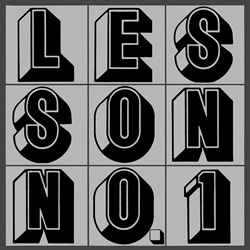 It’s not an exaggeration to say that the pioneering work of guitarist and composer Glenn Branca has, in a sense, become so enmeshed in today’s musical landscape that it’s almost impossible to judge the extent of his influence. At the very least, he played a pivotal role in the seminal No Wave scene in late-70s/early-80s New York, both as a member of Theoretical Girls and in his recruitment of musicians—such as Thurston Moore and Lee Ranaldo of Sonic Youth and Michael Gira of Swans—to help bring his compositions to life. Branca’s visionary use of his chosen instrument formed a foundation for much of the experimental guitar music that followed. With this in mind, it’s fortunate that Superior Viaduct has reissued Lesson No. 1, Branca’s first release under his own name. Significantly, this is the first time the record, which was originally released by 99 Records in 1980, has been reissued on vinyl.
It’s not an exaggeration to say that the pioneering work of guitarist and composer Glenn Branca has, in a sense, become so enmeshed in today’s musical landscape that it’s almost impossible to judge the extent of his influence. At the very least, he played a pivotal role in the seminal No Wave scene in late-70s/early-80s New York, both as a member of Theoretical Girls and in his recruitment of musicians—such as Thurston Moore and Lee Ranaldo of Sonic Youth and Michael Gira of Swans—to help bring his compositions to life. Branca’s visionary use of his chosen instrument formed a foundation for much of the experimental guitar music that followed. With this in mind, it’s fortunate that Superior Viaduct has reissued Lesson No. 1, Branca’s first release under his own name. Significantly, this is the first time the record, which was originally released by 99 Records in 1980, has been reissued on vinyl.
For those more familiar with Branca’s symphonies, which often utilized virtual armies of guitars, the line-up of musicians Branca assembled for Lesson No. 1 might come as a surprise. The record’s first track, “Lesson No. 1 For Electric Guitar,” is performed by a standard rock quintet: Branca and Michael Gross on guitars, augmented by Anthony Coleman on organ, F.L. Schroder on bass and Stephan Wischerth on drums. The track begins with a sharp, hypnotic guitar note pattern that establishes the piece’s central theme before a droning guitar begins to hover somewhere below. After a few minutes, the bass and drums add a slightly nervous urgency that propels the song to loftier heights. There are definite hints of Krautrock here, but “Lesson” veers toward territory that feels rawer, while at the same time generating a bright, even ecstatic mood. It’s an inspiring piece of music and a hell of an opening statement by Branca.
On the second side of the record is “Dissonance,” a composition that lives up to its billing. Featuring a similar line-up to “Lesson No. 1,” with only Branca playing guitar and Harry Spitz stepping in with a sledgehammer, “Dissonance” achieves drastically different results. Chiming guitars flit about like bats, the drums and bass sporadically fire industrial rhythms, and that sledgehammer literally pounds out spastic blasts of noise. Before too long, it all comes together, with the disparate elements somehow making perfect sense as they strike their various grooves. It’s a true experimental music tour de force and a template for various strains of noise music that followed.
Not found on the original version of Lesson No. 1 but appearing on the reissue is “Bad Smells,” a 1982 Branca composition commissioned by choreographer Twyler Tharp. Featuring an expanded line-up, including five guitarists, this piece serves as a sort of bridge between Lesson No. 1 and Branca’s later works. It also occupies a middle place between “Lesson No. 1 For Electric Guitar” and “Dissonance,” capturing both the light of the former and the darkness of the latter. Guitars appear all over the sonic spectrum here, wailing in the distance like ghosts, pounding out crashing percussive blasts, shooting fireworks above the rhythm section’s driving steam engine, and doing so much more during the track’s 16½ minutes. Between “Bad Smells” and the release’s two original tracks, this double 12-inch record set is an essential Rosetta stone for anyone interested in No Wave and its offshoots.

Your Comments